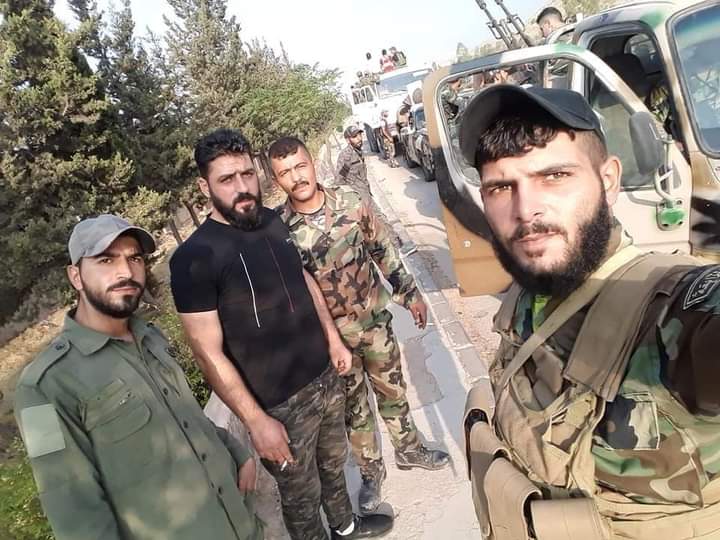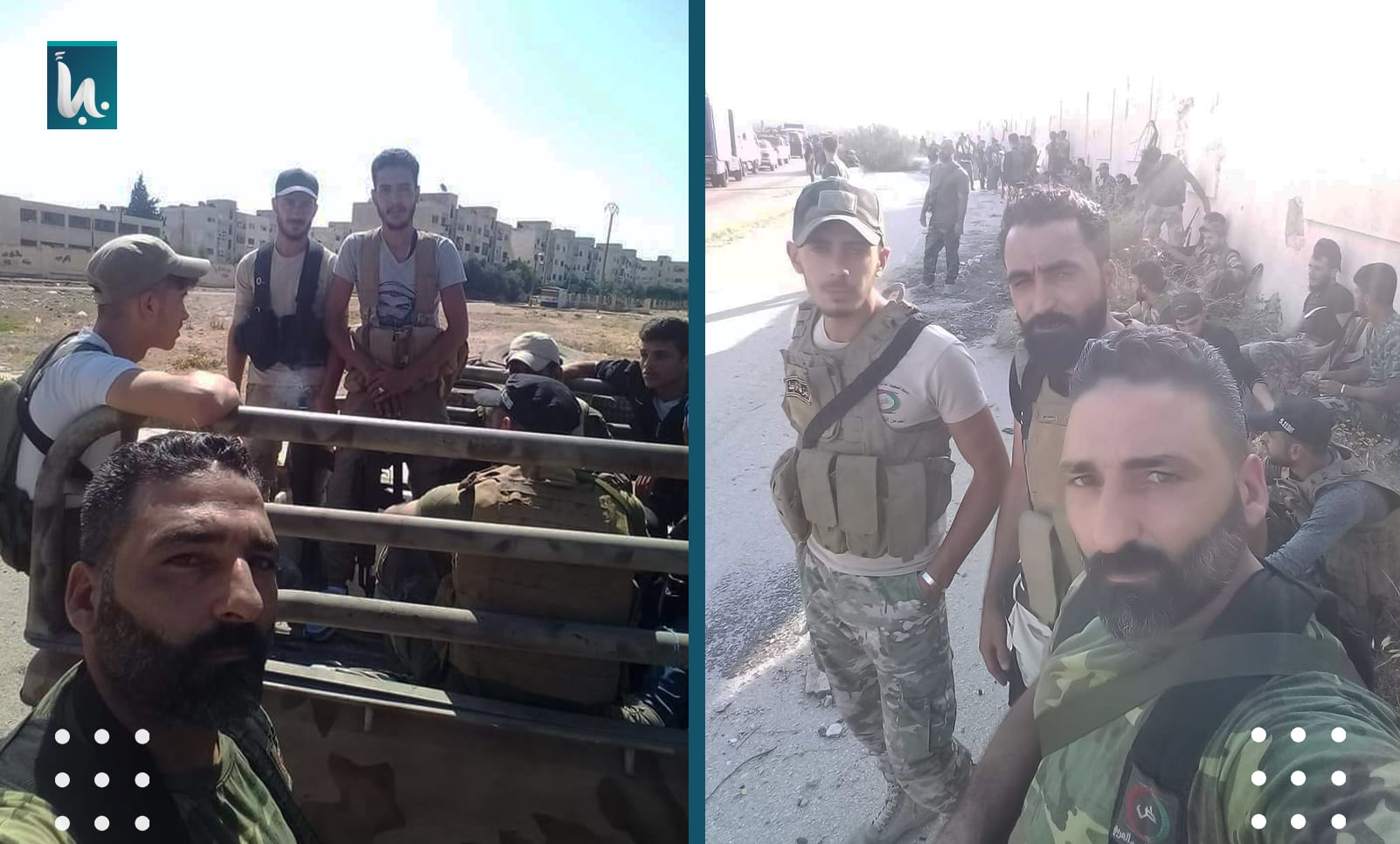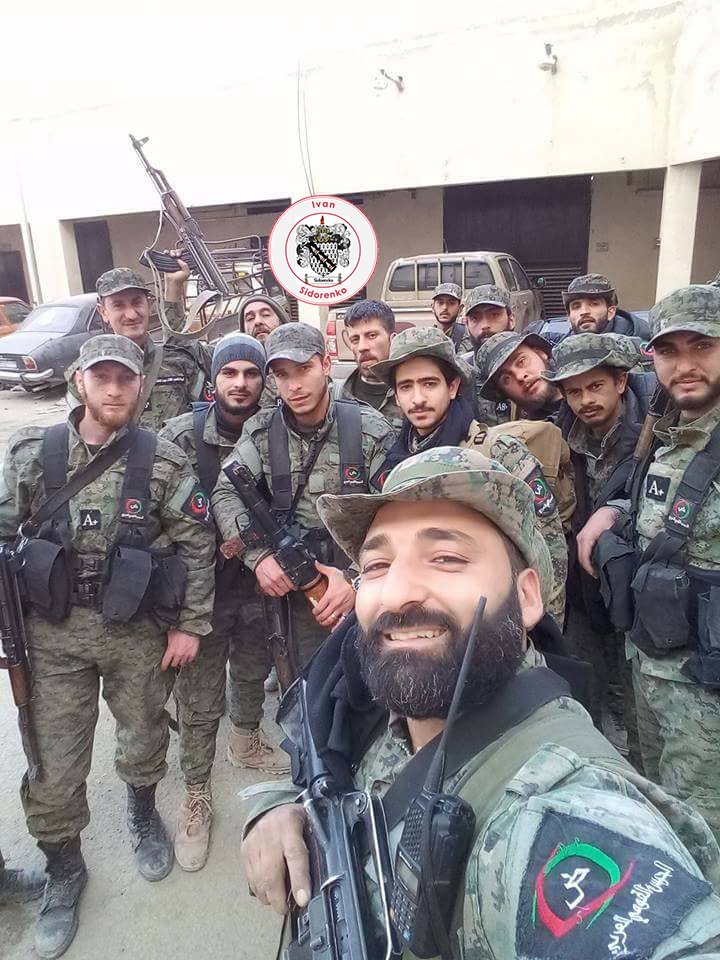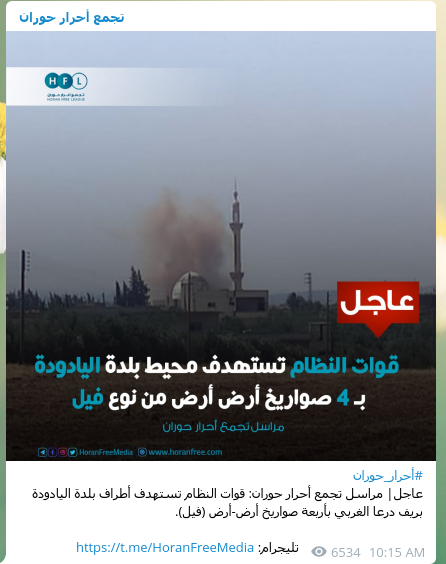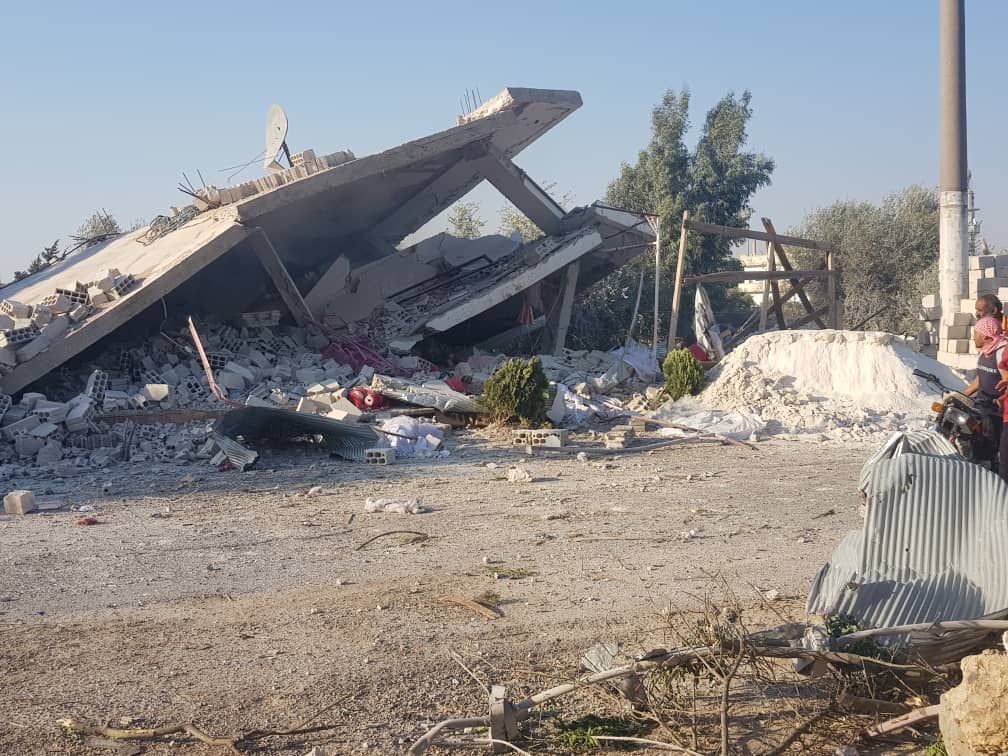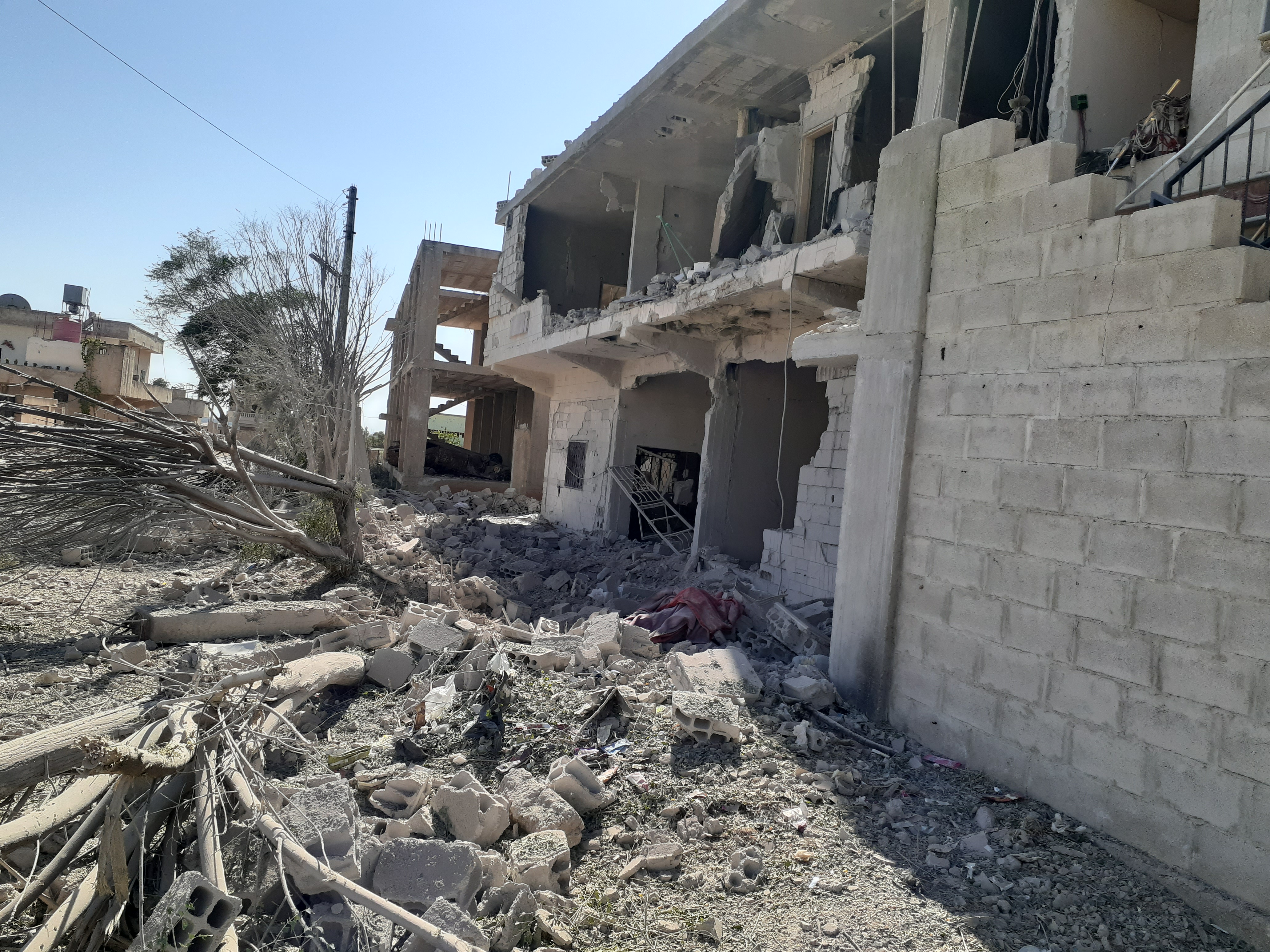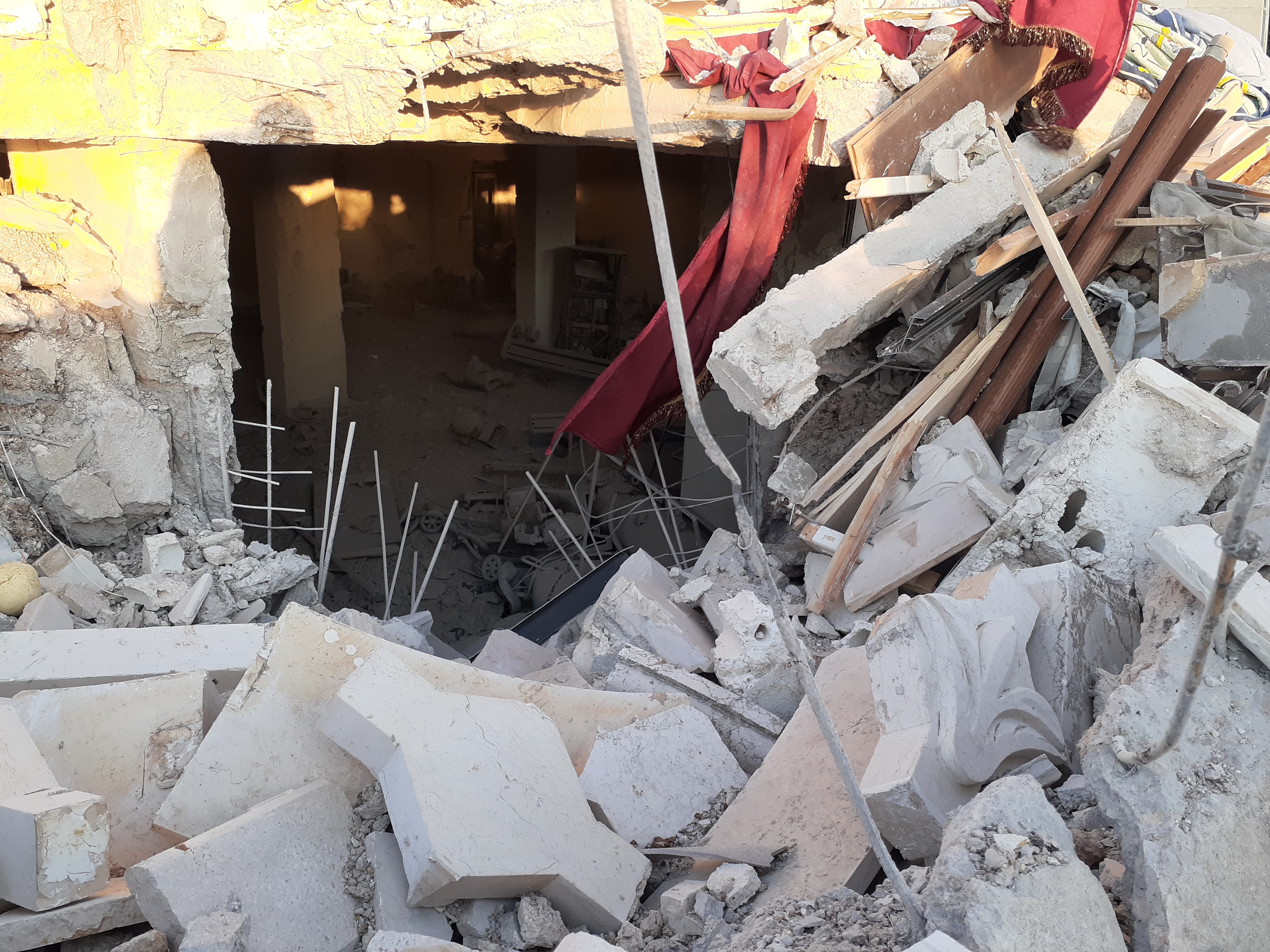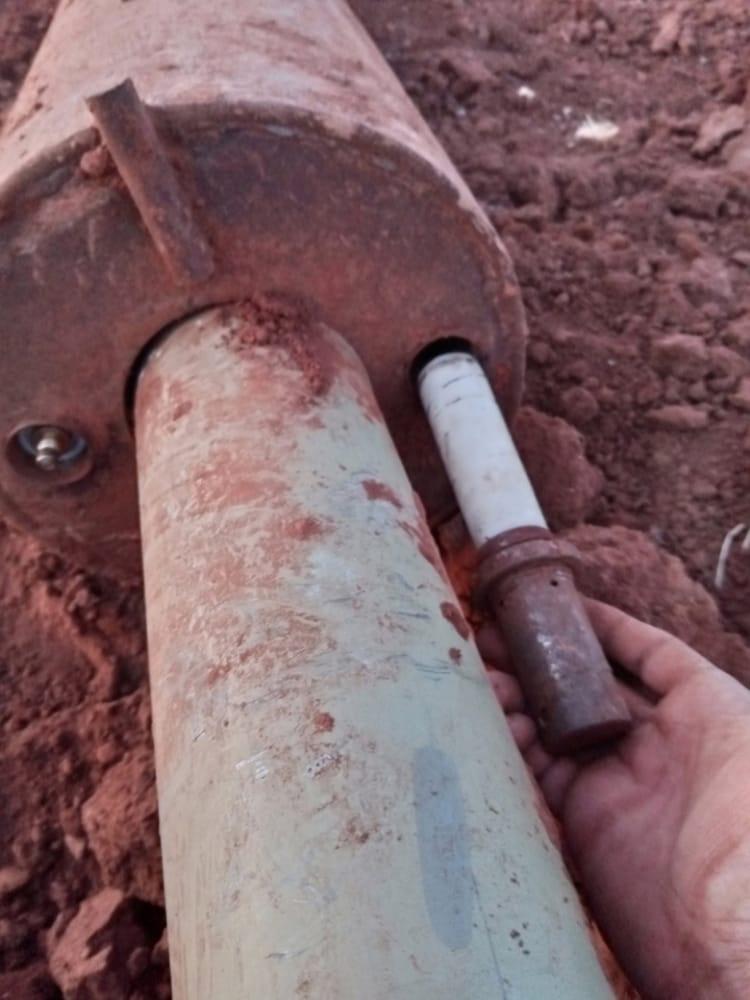Investigations
Multiple rockets hit civilian homes in the town of Al Yadoudah
September 28, 2021An investigation into the multiple rocket strikes that hit civilian homes in the town of Al Yadoudah in Daraa
Print Article
- Initial Summary
- Introduction
- Methodology
- Al Yadoudah Village
- Reinforcements Sent to Daraa
- What Happened (and When)?
- The Bombing of Ahmed Rakan Al Zoubi's Home
- The Bombing of Ibrahim Al Zoubi's Home
- Damage from the Attack
- The Victims of the Strikes on Civilian Homes
- Munitions Used
- Areas Bombed and the Parties Potentially Responsible
- Military Point 1A
- Military Point 2B
- Military Point 3C
- Military Point 4D
- Groups Involved in the Military Campaign on Daraa
- Conclusion
Table Of Contents
Joint investigation between Syrian Archive and Nabaa Media Foundation
Initial Summary
- Place of Incident: Daraa: Al Yadoudah
- Location Hit: Civilian homes in Al Yadoudah
- Date: 29 July 2021
- Time: Rockets hit Al Yadoudah from approximately 09:00 to 16:00 local time. Between 12:50 and 13:50, two of these rockets struck and killed civilians.
- Killed: Five civilians in total, including one woman and three children.
- Injured: 10 civilians, including two children
- Type of Incident: Multiple rocket strikes on 15 locations in Al Yadoudah
- Munitions Used: improvised rocket assisted munitions (IRAM)
- Potentially Responsible: Fourth Division of the armed forces and/or other Syrian government affiliated forces
Introduction
Hammam Ahmed Rakan survived a rocket strike on his family’s home in Al Yadoudah that killed his three brothers—Rita, Baraa, and Mohammed—and reduced his home to rubble.
A video shows Rita, Baraa, and Mohammed’s mother crawling towards her three children, after they were pulled from the rubble, to say goodbye to them. She holds her young daughter to her chest, telling her children that she will always miss them.
Not far from where an initial rocket landed, at the home of Ibrahim Al Zoubi, another rocket hit and killed a mother and her child. These attacks occurred during a violent and bloody day for civilians in the villages and towns in Daraa. On July 29, 2021, attacks killed 17 people in Daraa Al Balad, Al Mahata, Al Yadoudah, Tafas, Al Muzayrib, and Jasim.
From morning to early evening on July 29, 2021, the town of Al Yadoudah was allegedly hit by a variety of munitions including improvised rocket assisted munitions locally referred to as Elephant rockets. Launched by the Fourth Division from several military points, shelling came from areas surrounding the town. The attack killed five civilians, among them one woman and three children.
Methodology
Syrian Archive conducted an investigation into the incident by:
Collecting statements from eyewitnesses, journalists, and activists in the area;
Archiving, verifying, and analyzing 67 videos and photos uploaded to social media allegedly showing the impact of the attack on Al Yadoudah;
Contacting those who filmed and posted the content to verify the media, collect information about the bombing, and obtain original copies of the video or image to determine the exact place and time of recording; and
Determining the direction and location of the rockets’ impact, as well as the type of munition used, to identify the parties potentially responsible for the attack.
The combined analysis of these sources has culminated in the present investigation report. Considered together, the information gathered helps to establish the incident’s date, time, location, casualties, extent of damage, and potential perpetrators.
For more details on Syrian Archive’s methodology, please see our site.
Al Yadoudah Village
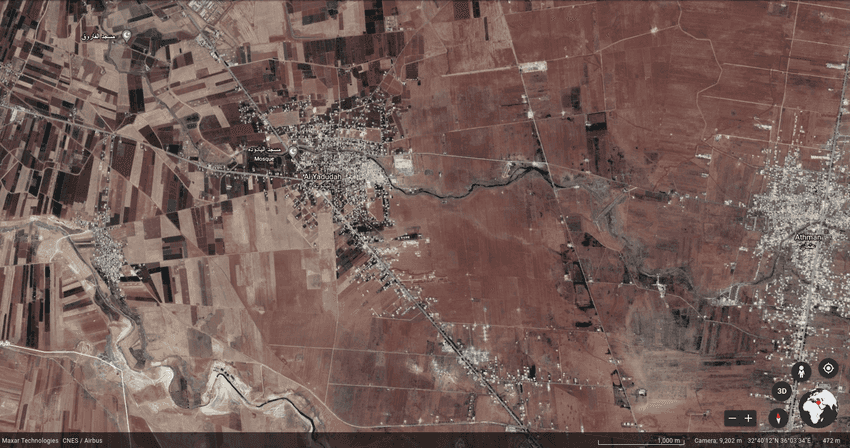 Satellite imagery from Google Earth showing the village of Al Yadoudah.
Satellite imagery from Google Earth showing the village of Al Yadoudah.
Al Yadoudah is the gateway to the western countryside of the Daraa govenorate. The town is about 5km northwest of the city of Daraa. It sits between Daraa city and the villages of Al Muzayrib and Tafas. Over 10,000 people live in Al Yadoudah. The town signed a reconciliation agreement with the Syrian government, enforced by Russian forces, at the beginning of July 2018 with Syrian government forces entering the town on July 11, 2018. Under the agreement, residents in the town were able to keep some of their own individual weapons. Shortly after the agreement, like in other villages and towns in Daraa, Al Yadoudah witnessed the arrests and harassment of village residents.
Reinforcements Sent to Daraa
On June 24, 2021, Syrian government forces led a siege on neighborhoods in Daraa Al Balad, Tariq Al Sad, and Daraa Camp. This occurred after the city’s central committee rejected the Syrian government’s demands to hand over all individual weapons and allow check points for government forces inside the city. The Syrian government requested more individual weapons from residents and demanded a larger security presence in the area in response to recent demonstrations rejecting the latest government elections and calling for the overthrow of the government and its president.
Initiating a siege, government forces called for reinforcements. Government troops mainly composed of Fourth Division units and Al Ghaith forces, in addition to other militias moved into the governorate. Videos posted online show the arrival of these military forces from Damascus and eastern Syrian to a station near Daraa Al Balad.
On July 24, after the siege persisted for a month, the Syrian government and Daraa residents agreed to hand over individual weapons and settle the status of around 200 wanted residents. The agreement also allowed for the installation of three government military points in Daraa Al Balad. Shortly after the agreement came into effect on July 26, government forces—including the Fourth and Ninth Divisions as well as other affiliated militias—stormed the Shayyah and Ghaz areas in Daraa.
Pictures and videos posted online throughout the past few weeks show military reinforcements entering Daraa. Pictures show soldiers in their uniforms with the Fourth Division logo and name. Videos posted online also mention the presence of Al Ghaith Forces, a militia affiliated with the Fourth Division, in Daraa, in addition to images of tanks and ground-to-ground rocket launchers. A video frequently circulated online also allegedly shows an attack on Daraa Al Balad with mortar shells. Other videos claim to show government forces storming Daraa Al Balad.
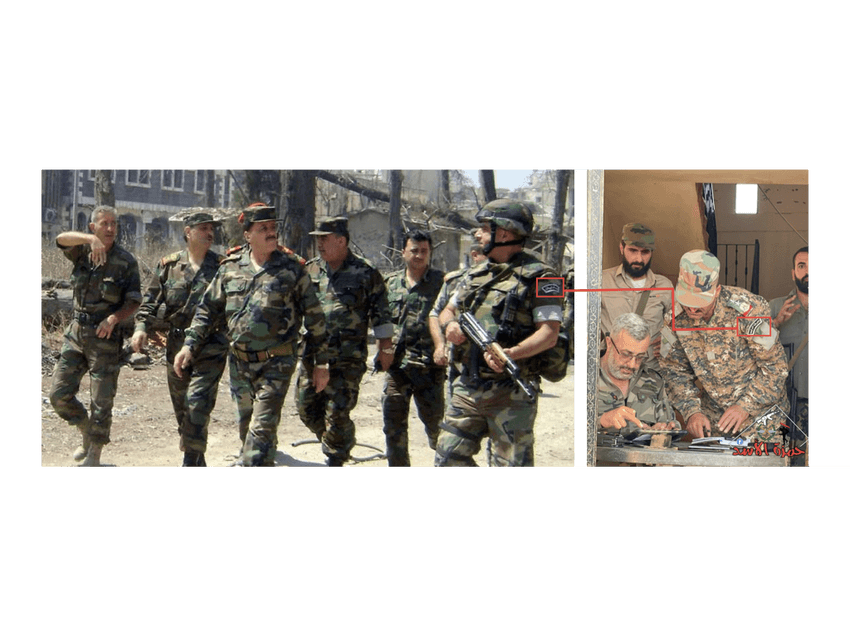 A comparison of Fourth Division uniform insignias as shown in an image—on the right—posted on July 30 of the Fourth Division and an AFP image—on the left—of the Fourth Division from 2018.
A comparison of Fourth Division uniform insignias as shown in an image—on the right—posted on July 30 of the Fourth Division and an AFP image—on the left—of the Fourth Division from 2018.
An audio recording, that Syrian Archive was unable to verify, was also frequently shared online. The recording was allegedly of a Syrian government military officer asking soldiers to target anyone who is seen carrying a weapon in Daraa. The officer in the recording calls residents of the town traitors. Another video, geolocated by Syrian Archive to outside Daraa city, shows an officer talking to group of Syrian army soldiers. In the video, the officer calls the government military campaign in Daraa a battle for revenge on the city.
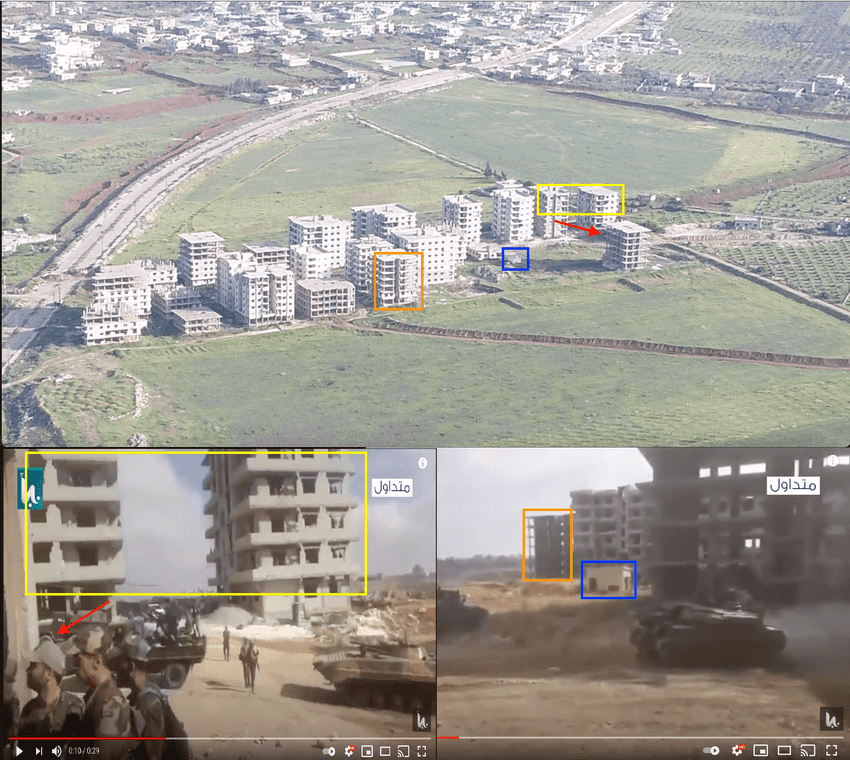 The geolocation of a video shows a group of Syrian army soldiers. The image at the top is an aerial photo was taken in 2018 and obtained by the investigation team
The geolocation of a video shows a group of Syrian army soldiers. The image at the top is an aerial photo was taken in 2018 and obtained by the investigation team
A picture showing members of the Fourth Division during the military campaign in Daraa.
Nabaa News Agency posted a photo showing members of the Arab Nationalist Guard with the Fourth Division during an attack from the south on Daraa. By reverse image searching the pictures of the fighters, Syrian Archive was able to identify one of the fighters as a participant in the military campaign on Al Yarmouk Camp, south of Damascus in 2018.
Pictures showing soldiers belonging to the Arab Nationalist Guard in the latest military campaign in Daraa and in the 2018 military campaign on Al Yarmouk camp.
In response to Syrian government forces storming the besieged neighborhoods of Daraa Al Balad on July 29, anti-government fighters in the villages and towns of Daraa began, what they called, the “Battle of Dignity”, in support of Daraa Al Balad. Residents took control of checkpoints belonging to the Syrian government and captured its soldiers. The fighting included clashes at a checkpoint near Al Yadoudah.
It was on this same day—while government forces stormed Daraa Al Balad and anti-government fighters in Daraa began the so-called Battle of Dignity—that Syrian government forces and allied militias stationed near the Al Nawfalah building on the Daraa Al Balad to Al Yadoudah road struck Al Yadoudah with a barrage of shells. Launched mostly from the northwestern and southwestern sides of Al Yadoudah, shells hit the homes of civilians.
What Happened (and When)?
On July 29, 2021, Al Yadoudah was hit by 15 strikes between 09:00 - 16:00. At least two of the strikes were from improvised rocket assisted munitions (IRAM)—locally known as Elephant rockets—that hit civilian homes and killed five people.
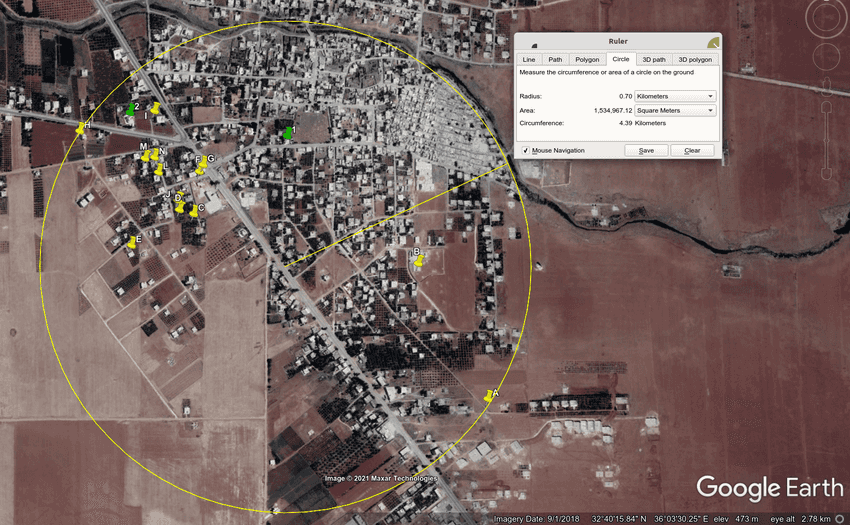 A map showing the locations hit in Al Yadoudah on July 29, 2021.
A map showing the locations hit in Al Yadoudah on July 29, 2021.
A number of news organizations published reports, videos, and photos on the attack on Al Yadoudah. Einab Baladi, Al Jazeera, Syria TV, and Baladi News reported on the strikes on the town and homes.
A video published by the Facebook page “Men of the Fourth Division #Ghaith Forces” shows the moment rockets were launched from a truck allegedly towards Al Yadoudah. The YouTube channel “Syrian Intelligence” uploaded a similar video on July 30, mentioning in the description that the video shows the July 29 bombing of Al Yadoudah.
Syrian Archive’s investigations team was able to identify the location of the launcher shown in the video as near the Al Nawfalah building on the Daraa Al Balad to Al Yadoudah road. The team also identified that the launcher shown in the video is pointed west, towards the village of Al Yadoudah.
The geolocation of Fourth Division rocket launch points. The yellow arrows indicate the direction of the rockets’ launch towards Al Yadoudah.
By analyzing the shadows shown in the video, the investigations team was also able to estimate the time the video was taken, and consequently when the rockets were launched. The shadows in the video match the position of the sun between 09:00 - 10:00 on July 29, 2021, as calculated using the SunCalc tool.
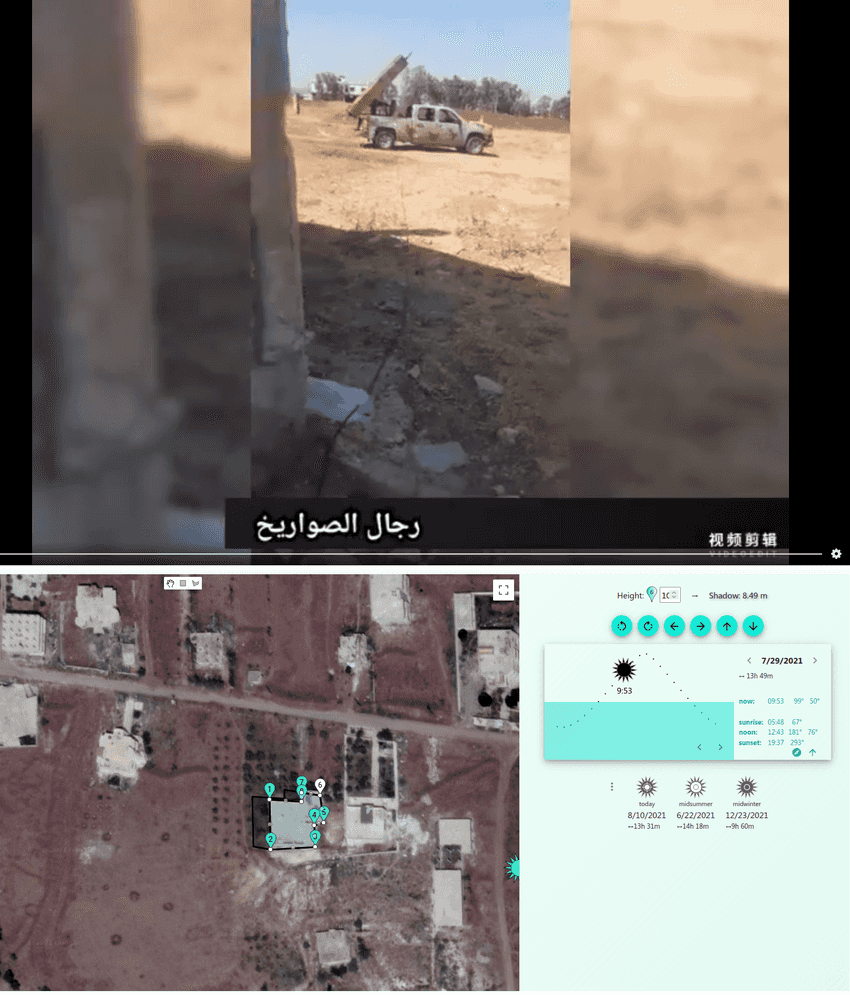 Shadows shown in a video posted on Facebook match the position of the sun, south of Al Yadoudah, between 09:00 - 10:00 AM on July 29, 2021. The position of the sun was calculated using SunCalc and Shadowcalculator.eu.
Shadows shown in a video posted on Facebook match the position of the sun, south of Al Yadoudah, between 09:00 - 10:00 AM on July 29, 2021. The position of the sun was calculated using SunCalc and Shadowcalculator.eu.
The timing of the rocket launches shown in the video mentioned above matches reports of an initial bombing on areas in Al Yadoudah. The Ahrar Houran Group Telegram channel posted news at 10:06 of mortar strikes on the town. Shortly thereafter at 10:16, the Telegram channel also posted alerts that Al Yadoudah was hit by Elephant rockets. For further confirmation, Syrian Archive contacted eyewitnesses and journalists from Al Yadoudah whose identities will remain confidential for their safety. Those who spoke with Syrian Archive confirmed that the bombing of the town started on the morning of July 29 with rockets launched from a point southeast of the town. According to Syrian Archive’s on the ground sources, five rockets landed east of the town the morning of July 29, hitting points A and B noted on the map below. These locations are residential homes near Al Yadoudah’s secondary school.
Screenshots from the Ahrar Houran Group Telegram channel of the first reports of the attack.
In the hours following the bombing of points A and B in Al Yadoudah, online alerts reported of additional strikes on the town one kilometer away from the first morning strikes. Around noon, 13 rockets hit nearly the same location. Rockets fell within a 320 meter radius. Syrian Archive spoke with victims of the attack who reported that the areas hit were all civilian homes. They also emphasized that there are no military headquarters or stations near the homes. Two of the rockets that hit Al Yadoudah killed civilians. The bombing of the area came from all sides of the town.
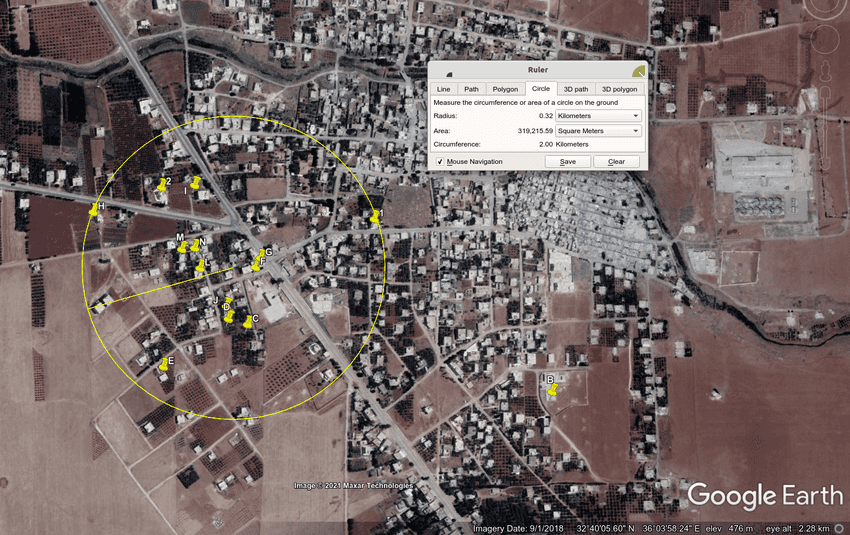 Satellite imagery from Google Earth showing the locations hit by the 13 rockets.
Satellite imagery from Google Earth showing the locations hit by the 13 rockets.
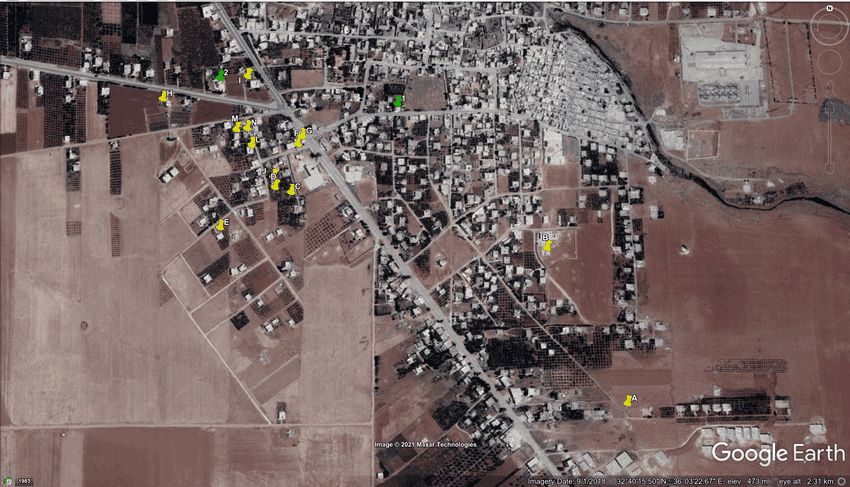 A map showing the locations hit in Al Yadoudah on July 29. The two incidents that resulted in fatalities are in green.
A map showing the locations hit in Al Yadoudah on July 29. The two incidents that resulted in fatalities are in green.
According to eyewitnesses and journalists in Al Yadoudah as well as photos and videos of an unexploded munition that reportedly landed in the town during the attack, Elephant rockets and other improvised rocket assisted munitions hit Al Yadoudah on July 29. A part of a shelling barrage that occurred within the same hour, the Elephant rockets and other improvised rocket assisted munitions directly hit two civilian homes destroyed in the attack. The first house hit belonged to Ahmed Rakan Al Zoubi. Three of his children were killed in the attack. The second house belonged to Ibrahim Abdul Rahman Al Zoubi, who lost his wife and child in the attack.
The Bombing of Ahmed Rakan Al Zoubi’s Home

A photo obtained by Syrian Archive’s investigations team shows the damage to Ahmed Rakan Al Zoubi’s house immediately after the strike.
At 13:52, news was posted on the Horan Ahrar Group Telegram channel of an attack on Al Yadoudah with Elephant rockets. Six minutes later at 13:58, additional news was posted of another attack, which killed civilians. The user Nabil Othman tweeted about the bombing claiming an Elephant rocket hit the town at 13:55, killing civilians. A few hours after the attack, Facebook user Abu Mays Badaqi posted about the attack on Al Yadoudah mentioning that the town was hit with Elephant rockets that killed civilians. At 14:14, Nebaa News Network posted a photo and report of the attack on Al Yadoudah mentioning that three children were unable to be extracted from under the rubble. Reports followed on the recovery of the bodies of those killed in the attack as well as the destruction of the civilian area.
Screenshots from the Ahrar Houran Group Telegram channel of the initial reports of the attacks on Al Yadoudah.
Syrian Archive obtained original photos and videos that show similar scenes to what was posted on social media. Syrian Archive obtained a video showing the house of Ahmed Al Zoubi immediately after it was attacked, during efforts to extract the children from under the rubble. By analyzing the metadata of this video, Syrian Archive was able to verify the timing of the incident as around 13:14:05 on July 29, 2021.
![]() A screenshot of a graphic video obtained by Syrian Archive showing the efforts to rescue victims from under the rubble of Ahmed Al Zoubi’s house.
A screenshot of a graphic video obtained by Syrian Archive showing the efforts to rescue victims from under the rubble of Ahmed Al Zoubi’s house.
 An image of the video’s metadata.
An image of the video’s metadata.
Eyewitnesses interviewed by Syrian Archive said that an Elephant rocket fell directly onto Ahmed Al Zoubi’s house, completely destroying it. The home, according to witnesses, was a two-story building. The complete destruction of Ahmed Al Zoubi’s home corroborates claims that an Elephant rocket, and not a mortar shell or Grad rocket, was used in the attack. As described below, Elephant rockets often produce greater damage than mortar shells or other improvised munitions.
Videos and photos posted online and obtained by Syrian Archive show Ahmed Al Zoubi’s house completely destroyed by the attack with collapsed ceilings and walls. The photos of the victims killed in the attack on Ahmed Al Zoubi’s home match photos of the victim‘s home from before the strike.
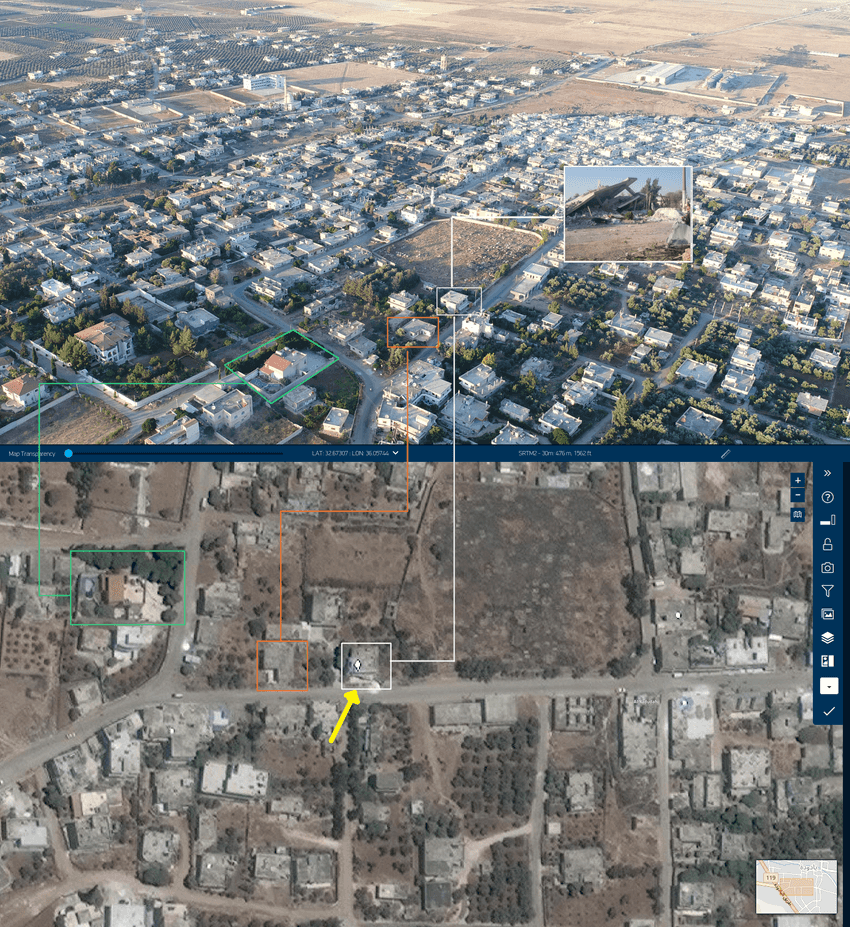 A geolocation of Ahmed Al Zoubi’s home in Al Yadoudah.
A geolocation of Ahmed Al Zoubi’s home in Al Yadoudah.
According to witnesses that spoke to Syrian Archive, the rocket left no visible crater or entry hole inside the home. The Syrian Archive team used the damage to Ahmed Al Zoubi’s home to identify the potential launch direction of the rocket in the attack. While not determinative, the complete destruction of the southern and eastern walls of the home suggests the rocket in the attack was launched from southwest of Al Yadoudah.
{
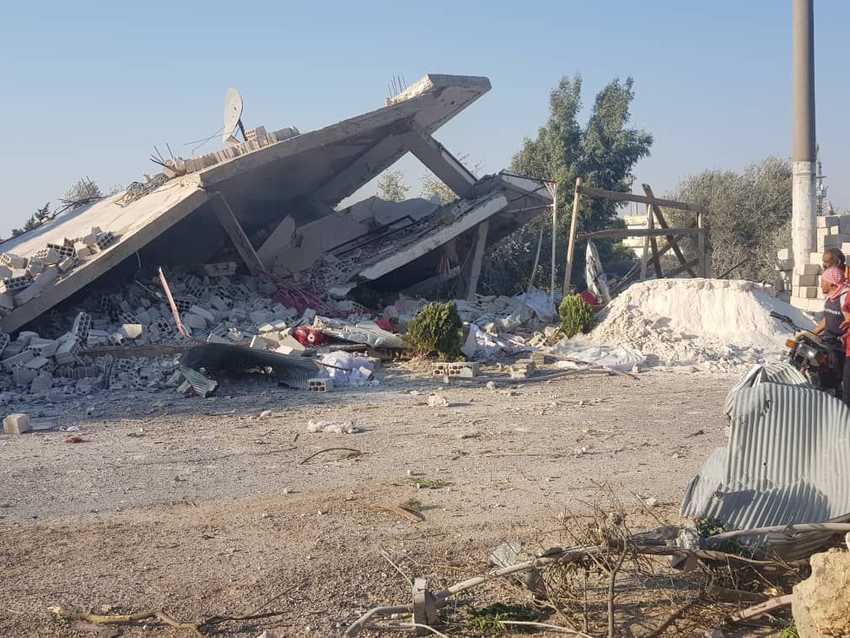
A photo obtained by Syrian Archive’s investigations team shows the damage on the southwest corner of Ahmed Rakan Al Zoubi’s house.
Journalists and eyewitnesses that spoke to Syrian Archive reported seeing government forces launching rockets on July 29 from the southwestern side of the city, about 2km away from the town. Syrian Archive was unable to further corroborate these claims at this time.
{
 Satellite imagery from Google Earth Pro showing the distance between fields southwest of Ahmed Rakan Al Zoubi’s home—a potential launch site for the rockets that hit areas of Al Yadoudah—and Ahmed Rakan Al Zoubi’s home.
Satellite imagery from Google Earth Pro showing the distance between fields southwest of Ahmed Rakan Al Zoubi’s home—a potential launch site for the rockets that hit areas of Al Yadoudah—and Ahmed Rakan Al Zoubi’s home.
The Bombing of Ibrahim Al Zoubi’s Home
A video obtained by the Syrian Archive team shows the damage to Ibrahim Al Zoubi’s home.
A video obtained by Syrian Archive shows the damage of another rocket that hit Ibrahim Al Zoubi’s house and killed his wife and child. The investigations team was able to to determine the location of the house using aerial photographs from 2018 of Al Yadoudah, photos and videos obtained by the team from individuals on the ground, and videos and photos posted online of the aftermath of the attack.
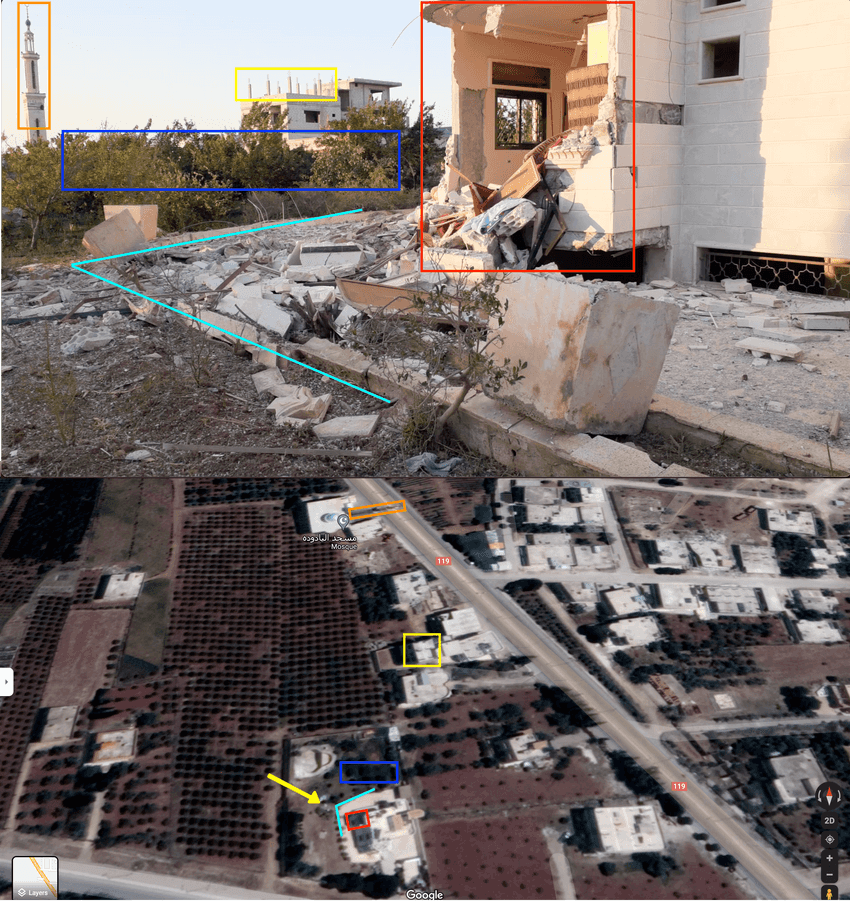 The geolocation of Ibrahim Al Zoubi’s house in Al Yadoudah.
The geolocation of Ibrahim Al Zoubi’s house in Al Yadoudah.
The Metadata in photos and videos obtained by Syrian Archive corroborate the date and time rockets hit Al Yadoudah. Additionally, videos and photos obtained by Syrian Archive, show a potential rocket entry hole on the northwestern side of the house indicating that the rocket may have been launched from that direction.
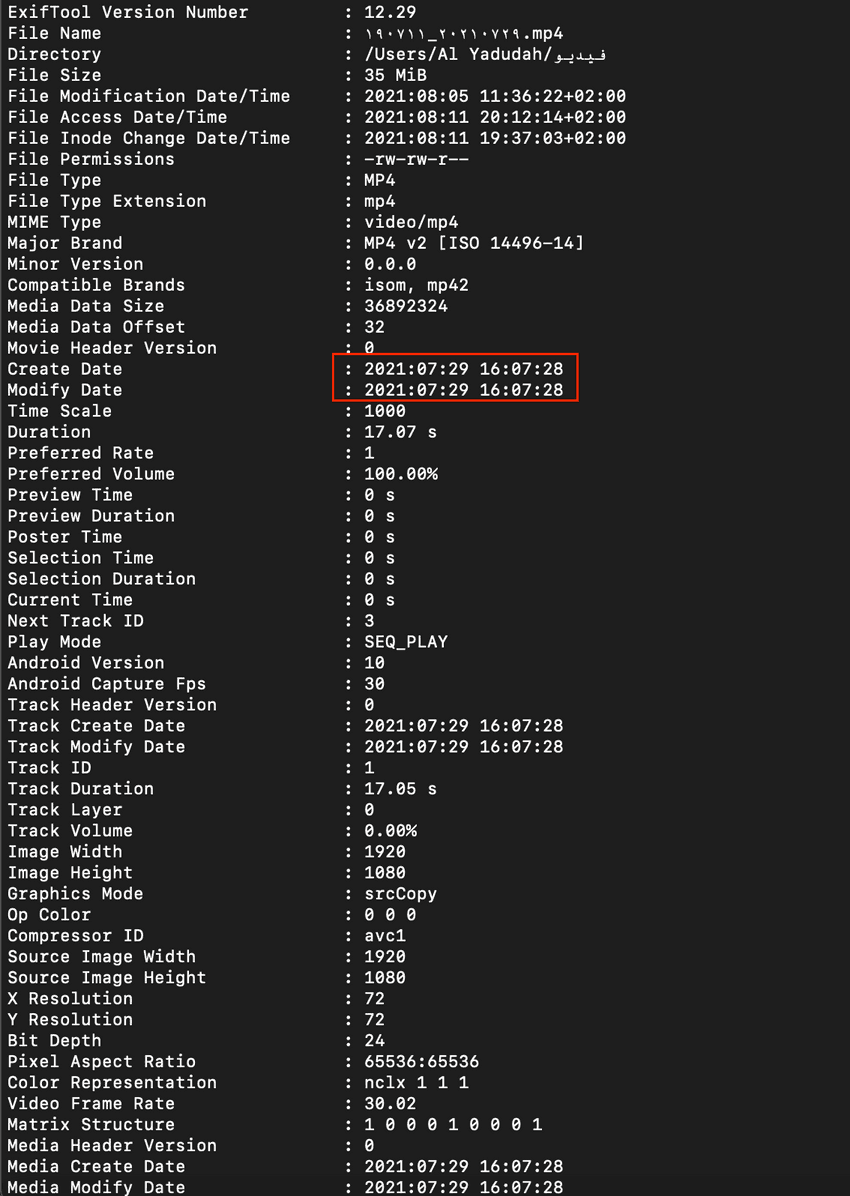 The metadata of a video obtained by Syrian Archive showing the damage to Ibrahim Al Zoubi’s house.
The metadata of a video obtained by Syrian Archive showing the damage to Ibrahim Al Zoubi’s house.
Damage from the Attack
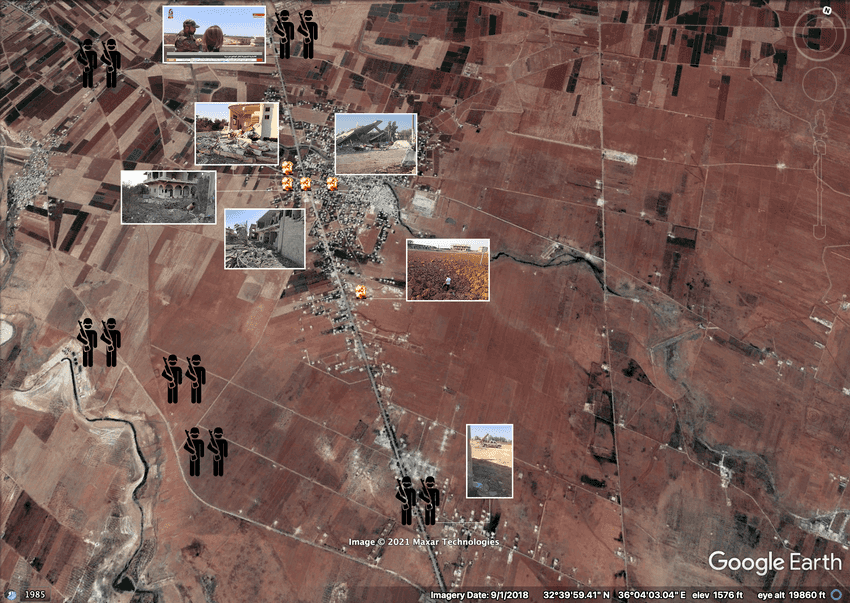 A map showing some of the locations hit in Al Yadoudah on July 29, 2021.
A map showing some of the locations hit in Al Yadoudah on July 29, 2021.
The shelling of Al Yadoudah completely and partially destroyed several homes. Syrian Archive identified all the sites of impact in Al Yadoudah.
Pictures obtained by the Syrian Archive team show the destruction to civilian homes and infrastructure caused by the bombing of Al Yadoudah.
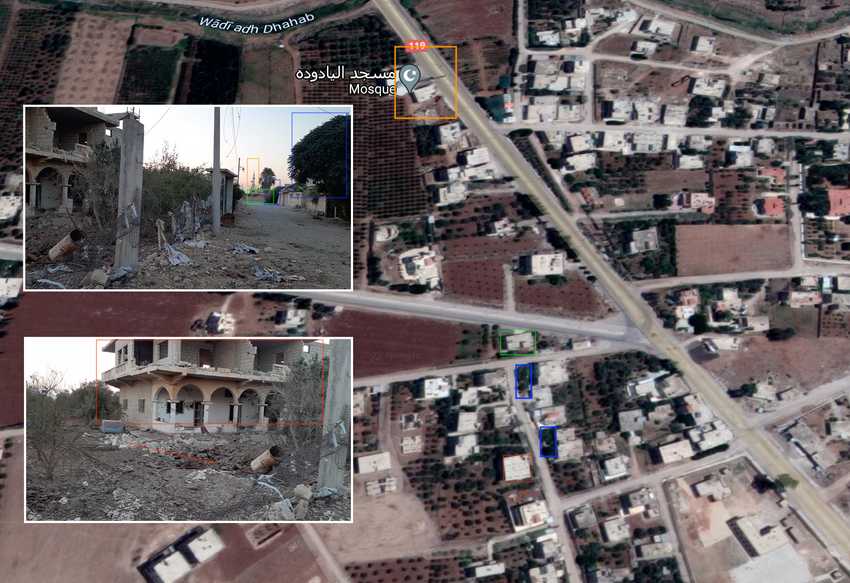
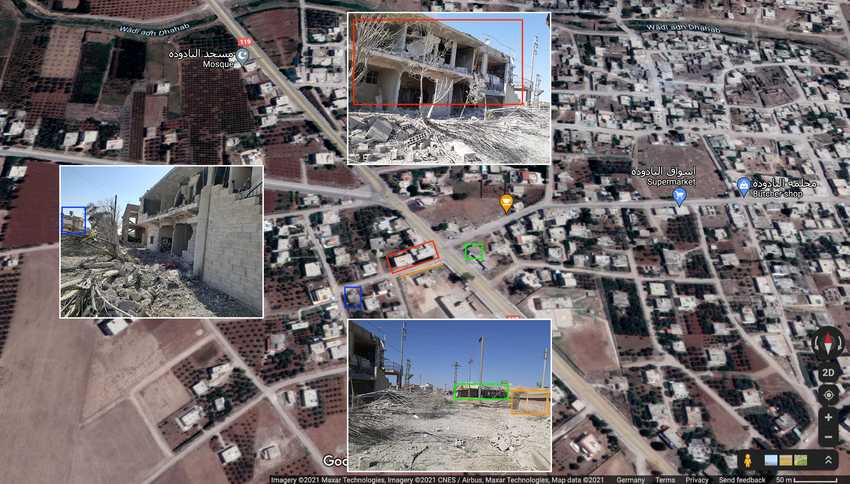 Houses destroyed in the shelling of Al Yadoudah.
Houses destroyed in the shelling of Al Yadoudah.
The Victims of the Strikes on Civilian Homes
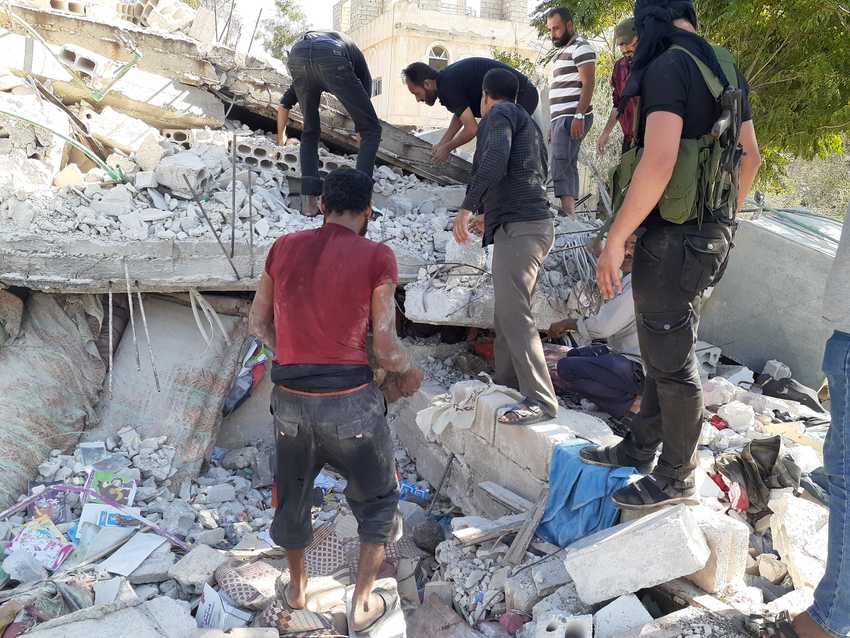 *A picture showing the efforts to remove victims from under Ahmed Rakan Al Zoubi’s Home.
*A picture showing the efforts to remove victims from under Ahmed Rakan Al Zoubi’s Home.
The attack on the town of Al Yadoudah on July 29, 2021, resulted in five fatalities including three of Ahmed Al Zoubi’s children and Ibrahim Al Zoubi’s wife and son. Their photos were confirmed and matched with old photos of the victims posted online. Journalists who spoke to Syrian Archive also confirmed the number of fatalities.
- Nahla Fayez Nasser Al Zombi (wife of Ibrahim Al Zoubi)
- Hamza Ibrahim Al Zoubi
- Baraa Ahmed Rakan Al Zoubi
- Mohammed Ahmed Rakan Al Zoubi
- Ritaj Ahmed Rakan Al Zboui
Munitions Used
The media and witness testimony reviewed above suggest that Al Yadoudah and the surrounding area were targeted by improvised rocket assisted munitions (IRAM), which are locally referred to as Gulan rockets. Syrian Archive analyzed photos and videos of an unexploded munition that landed in Al Yadoudah on July 29, 2021, that share similar features with other locally modified rocket munitions.
The following pictures, obtained from a confidential source, shows an unexploded rocket reportedly used in the attack on Al Yadoudah.
Pictures obtained by Syrian Archive showing the unexploded rocket that landed in Al Yadoudah on July 29, 2021.
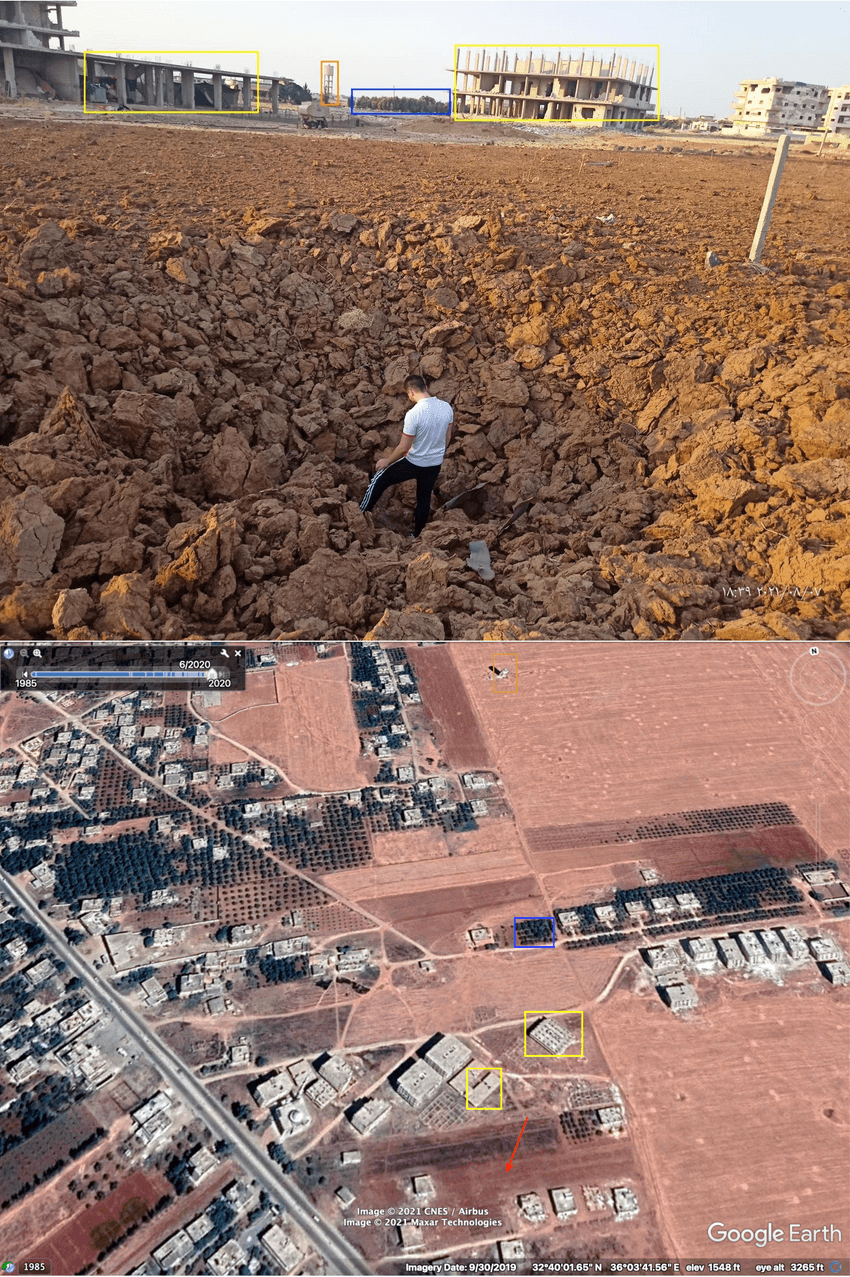 A geolocation of where the unexploded rocket was found.
A geolocation of where the unexploded rocket was found.
In the Syrian conflict, IRAMs were first used by Syrian government forces and later by some opposition groups. Syrian Archive collected videos and images showing IRAMs previously used in Syria in an effort to identify the munition shown in the pictures above.
A number of pictures found online show IRAMs that match in shape and structure to Gulan rockets as identified by Armament Research Services (ARES) and the Global Public Policy Institute (GPPI). Among other features, these munitions include two distinct fuses at the base of the rocket head. These fuses are shown in diagrams drawn by researchers at ARES and GPPI as well as in the pictures of the unexploded munition in Al Yadoudah . Additionally, pictures obtained by Syrian Archive and gathered from online sources show the Gulan rocket’s distinct tail. The tail includes fins attached to the rocket’s cylinder and to a lower metal plate, forming a half cylinder shape. This matches diagrams and images provided by ARES and GPPI of the Gulan rocket.
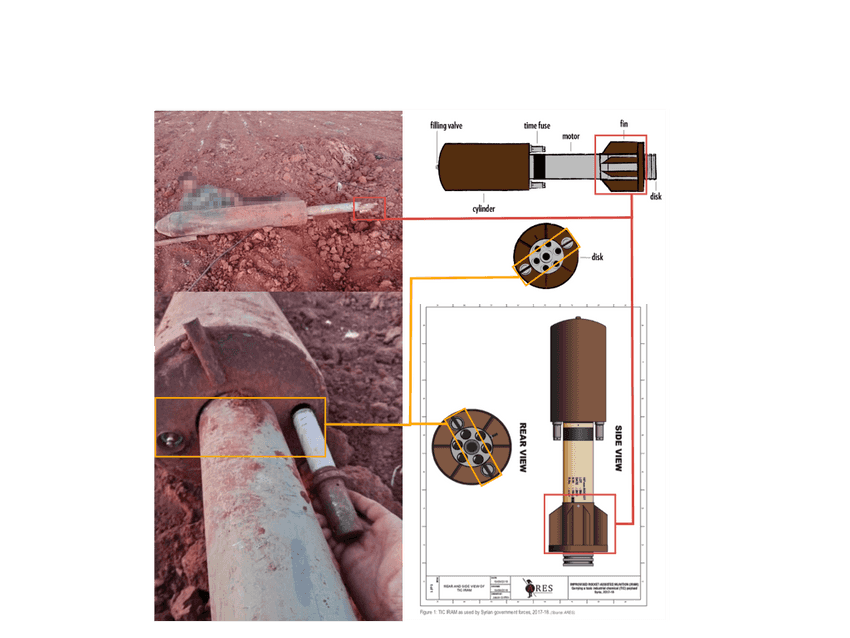
A comparison of diagrams provided by ARES and GPPI with pictures given to Syrian Archive of an unexploded munition that landed in Al Yadoudah during the July 29 attack.
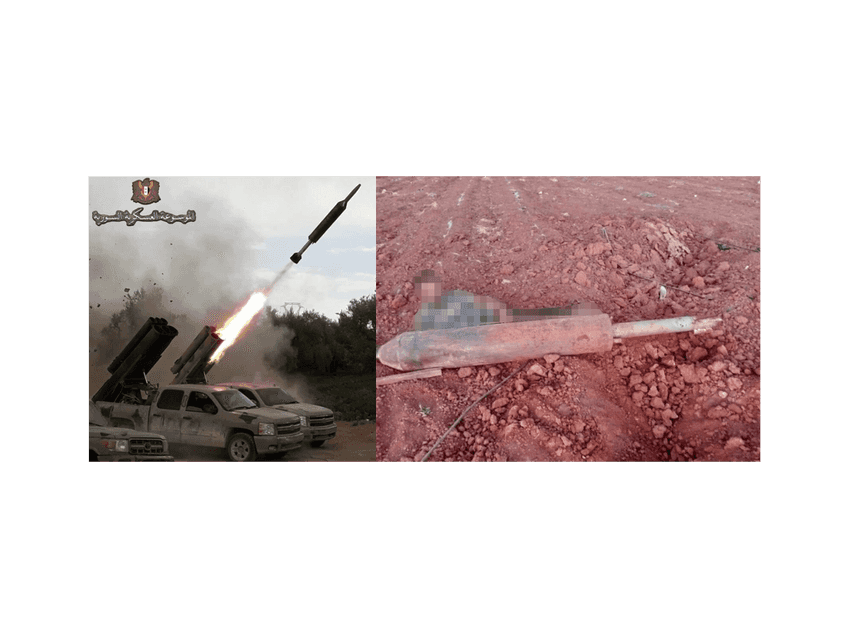
A picture (left) posted by the Facebook page Encyclopedia of Syrian Military of a Gulan rocket and a picture (right) obtained by Syrian Archive of the unexploded munition that landed in Al Yadoudah.
Syrian Archive additionally matched footage showing rocket launchers near Al Yadoudah the day of the attack with pictures of Gulan rocket launchers previously used by the Syrian military. In an album titled “Syrian Army - Rocket Launchers and Ballistic Missiles,” the Facebook page Encyclopedia of Syrian Military includes a number of photos of Gulan rocket launchers belonging to the Syrian government. The page specifically includes a picture allegedly showing two calibers of Gulan rockets.
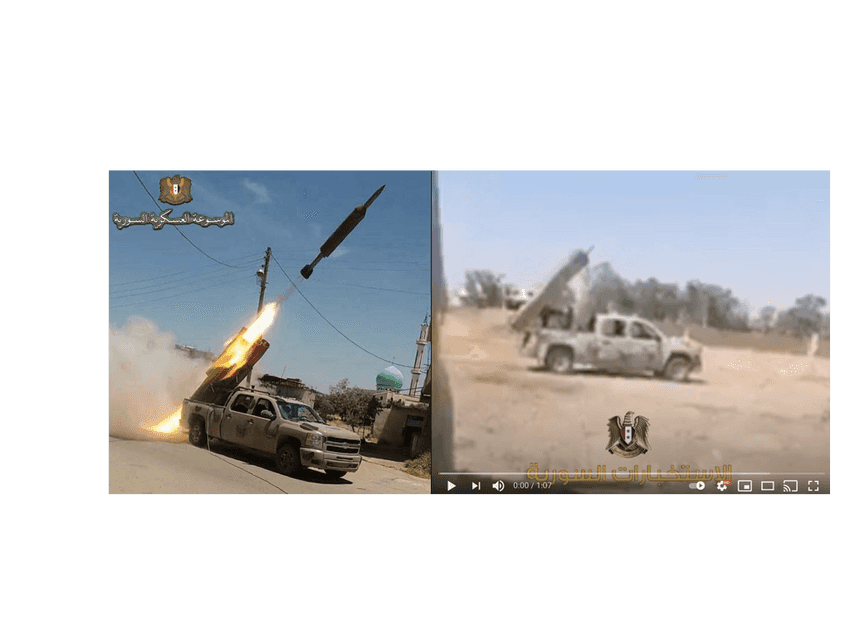
An image of Gulan rocket launchers. The left image was posted by the Encyclopedia of Syrian Military Facebook page. The right image is a screenshot from a video verified by Syrian Archive showing missiles being fired towards Al Yadoudah on July 29.
A video—verified by Syrian Archive—showing the Syrian military launching rockets towards Al Yadoudah on July 29, features a rocket launcher that matches pictures posted online of Gulan type rocket launchers. By further comparing pictures of the Gulan-250 and the larger Gulan-400 type launchers, Syrian Archive found that the unexploded munition was most likely a Gulan-250 type. Although, the Gulan-400 also may have also been used in the attack. As mentioned by both ARES and GPPI, Gulan rockets have often been used by the alleged perpetrator of the July 29 attack on Al Yadoudah, the Syrian army’s Fourth Division.
Areas Bombed and the Parties Potentially Responsible
Syrian Archive was able to identify, through witness testimony and the verification of a number of videos, multiple military points within a 3km radius of Al Yadoudah where munitions that hit the town may have been launched.
Military Point 1A
Eyewitnesses reported to Syrian Archive that a military point and firing range for Syrian government forces was located in fields adjacent to a desalination plant around 2km southwest from the town center. According to witnesses, the fields were also where launchers for various weapons, including Elephant rockets, were held. Local journalists reported that Fourth Division forces, and affiliated militias, as well as Lebanese Hezbollah were stationed at these points. Several unverified maps posted on twitter corroborate witness statements and show the potential distribution of Syrian government forces around Daraa and Al Yadoudah.
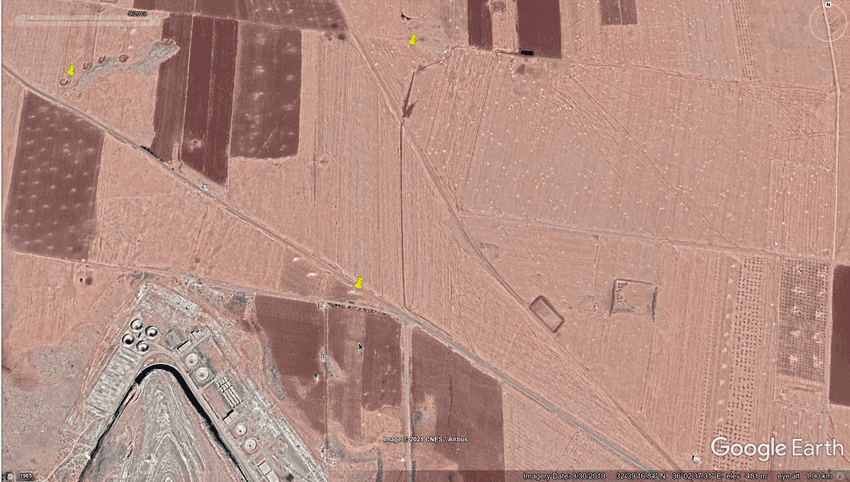 A satellite image showing the fields southwest of Al Yadoudah and near the desalination plant.
A satellite image showing the fields southwest of Al Yadoudah and near the desalination plant.
Military Point 2B
Another point was revealed in videos posted online showing the shelling of towns in Daraa. Specifically, a video showing the shelling of Daraa by government forces posted by the Facebook page “The Men of the Fourth Division #Al Ghaith Forces” the day after the attack was found by Syrian Archive to have been taken at a military point about 2.8 km southeast of Al Yadoudah.
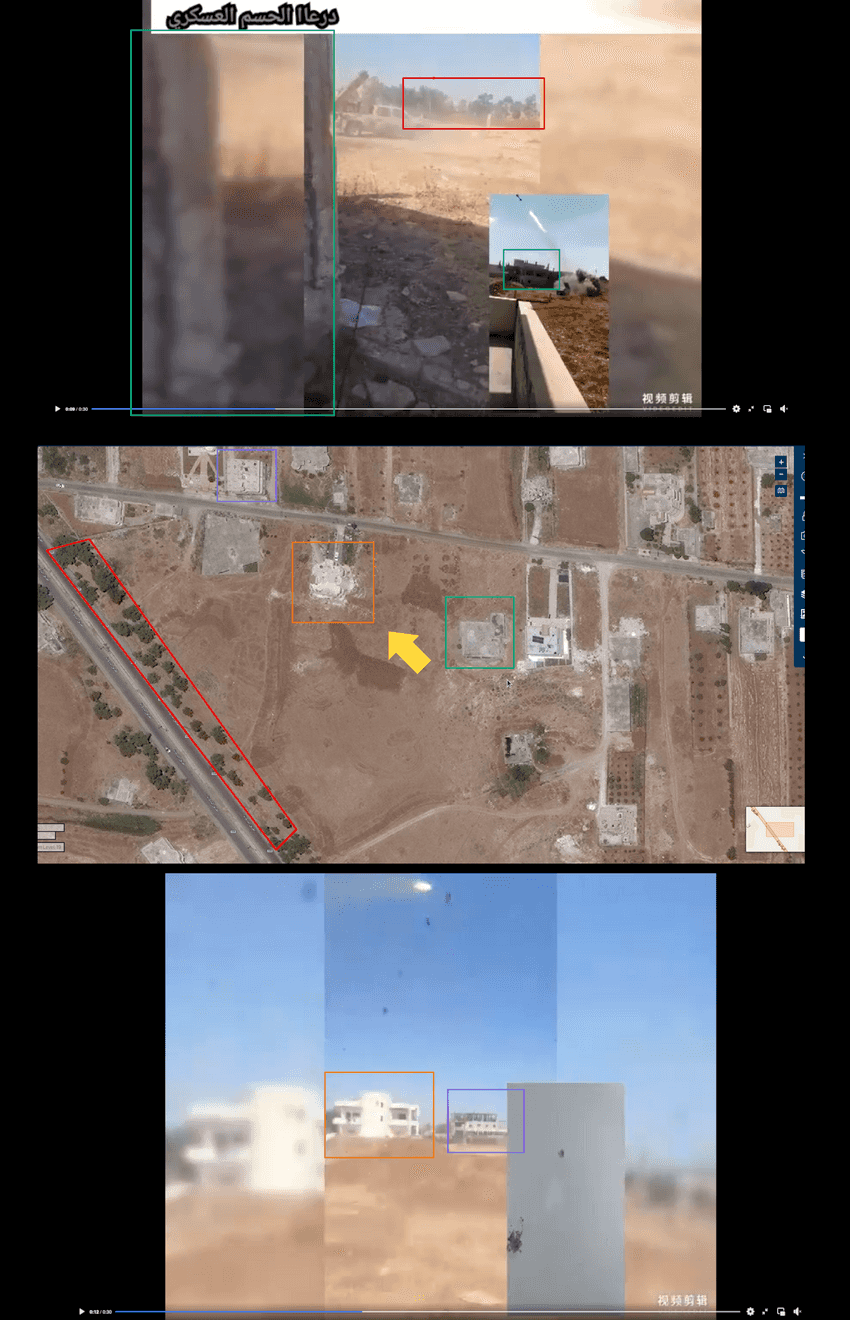 Geolocation of a Syrian government military post southeast of Al Yadoudah.
Geolocation of a Syrian government military post southeast of Al Yadoudah.
Military Point 3C
Syrian Archive additionally found and verified another video posted three days after the attack showing government forces at a military point. Syrian Archive located Syrian government forces shown in the video as 2km north of Al Yadoudah’s town center.
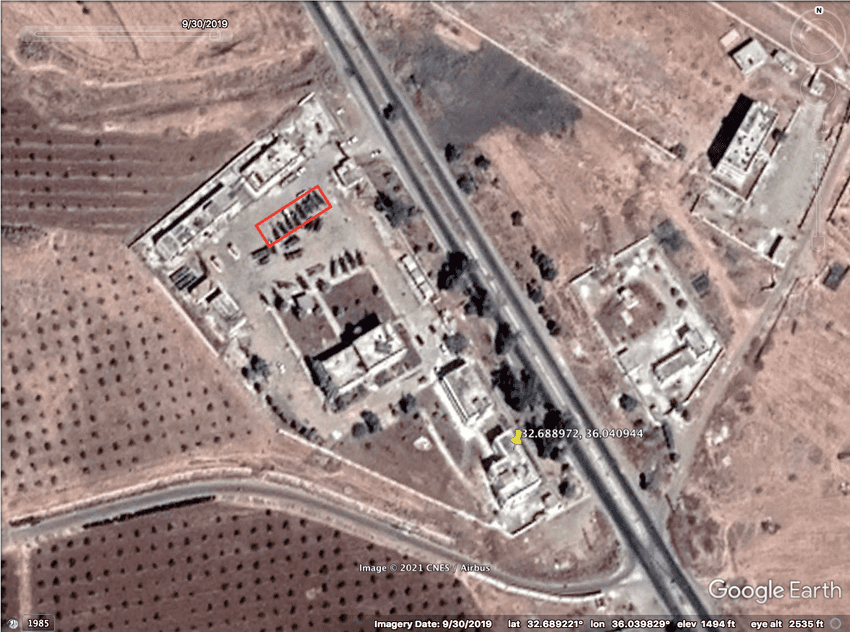
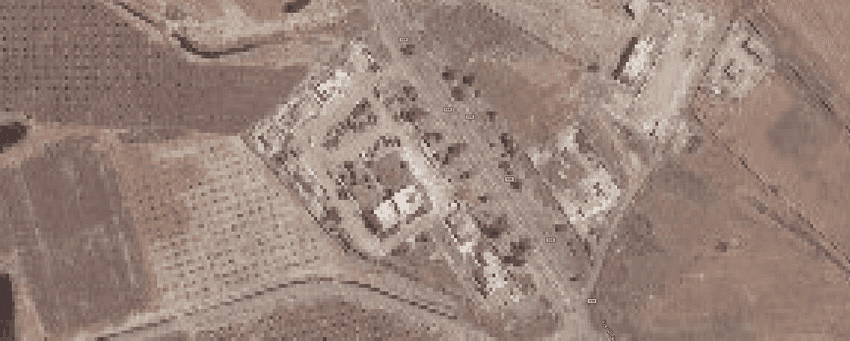 Satellite imagery from Google Earth Pro (first image) and Maxar (second image) taken in September 2019 and May 2021 show military vehicles at Military Point 3C.
Satellite imagery from Google Earth Pro (first image) and Maxar (second image) taken in September 2019 and May 2021 show military vehicles at Military Point 3C.
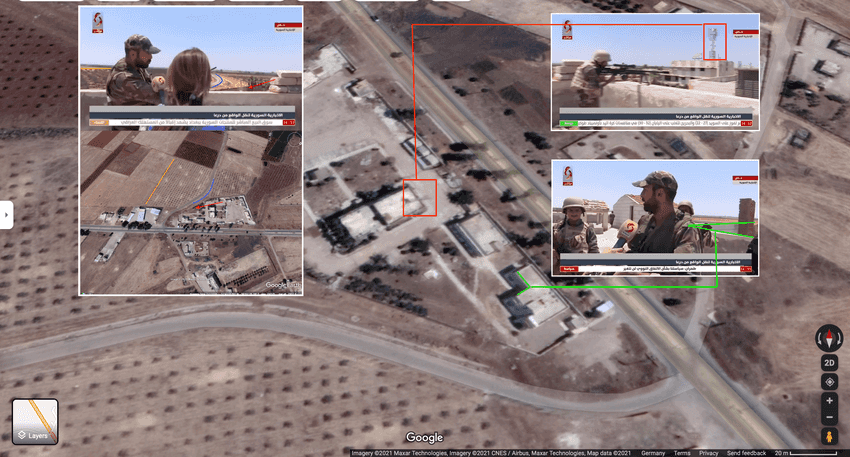 Geolocation of a Syrian government military post north of Al Yadoudah.
Geolocation of a Syrian government military post north of Al Yadoudah.
Military Point 4D
Sources also spoke to Syrian Archive of a designated military point called Al Salam Station, located 2km northwest of Al Yadoudah. Sources on Twitter claim it was a gathering place for the Fourth Division. Satellite imagery of this location shows a gathering of military vehicles, indicating a potential military point.
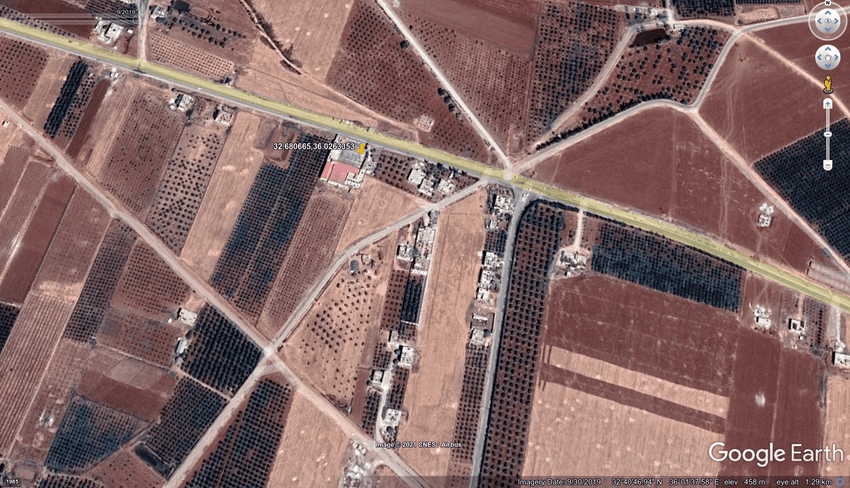 An image showing a collection of military vehicles northwest of Al Yadoudah.
An image showing a collection of military vehicles northwest of Al Yadoudah.
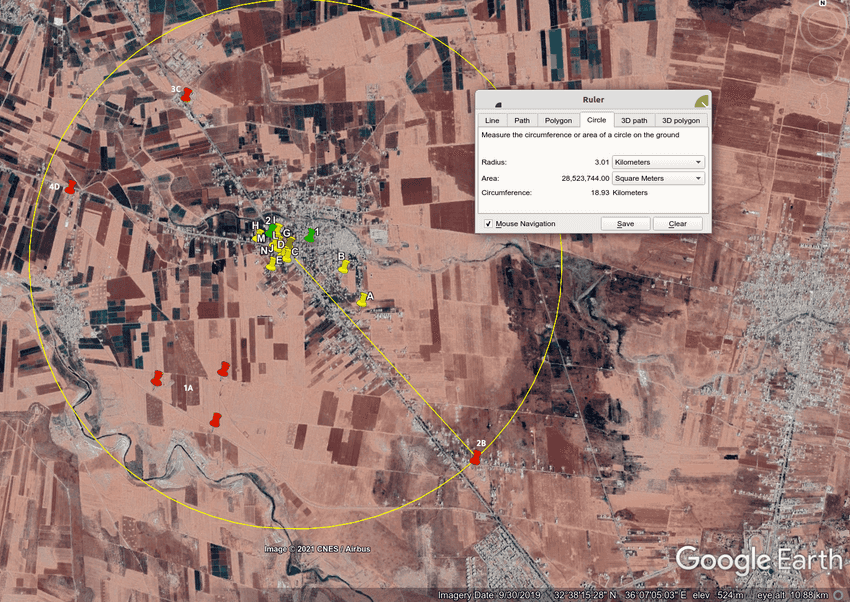 An image showing the location of Syrian government forces around Al Yadoudah.
An image showing the location of Syrian government forces around Al Yadoudah.
As mentioned above, these identified points are within a 3 km radius of Al Yadoudah, matching the short 2-4km range of an IRAM or Elephant rocket. When comparing the damage to specific points hit in Al Yadoudah with the location of the identified launch points, Syrian Archive was able to estimate which military points are potentially responsible for specific attacks on Al Yadoudah on July 29.
Given the limited range of the potential munitions used, the shelling that hit the southern points A and B at 09:30, as indicated on the map, most likely came from the southeast, around Military Point 2B. Shelling that hit the home of Ibrahim Al Zoubi—Point 2 on the map—at around 14:00, severely damaging the homes northern and western walls—indicating the munitions launch direction was from the west—likely came from the gathering of military vehicles northwest of Al Yadoudah, Military Point 4D. Lastly, given its location on the western side of Al Yadoudah, the rockets that hit the home of Ahmed Rakan Al Zoubi at around 13:15, Point 1 on the map, most likely came from the fields southwest of Al Yadoudah, Military Point 1A.
Groups Involved in the Military Campaign on Daraa
15 Special Forces Division
The 15th Division in the Syrian Army was established in the 1990s and is based in the As-Suwayda Governorate. The division specializes in light infantry operations. The division consists of four regiments. Beginning in 2011, three of the four regiments were transferred to Homs where they fought against opposition groups. Major General Mohieldin Mansour led the division until 2013 when Major General Ali Asaad took control. Major General Ali Asaad left the division 2020 and is claimed to be responsible for numerous human rights violation committed in Daraa and As-Suwayada. The 15th Division participated in battles in the Daraa Governorate up until the reconciliation agreements in 2018. Al Asaad is from Tartus and joined the 15th Division in 2011. He left the division after he was made commander in 2020 of the Syrian military’s 1st Corps. After Al Asaad, Major General Issa Suleiman from Homs was made commander of the 15th Division.
 A picture posted by Facebook user Nazir Al Aqeel showing alleged members of the 15th Division in Daraa
A picture posted by Facebook user Nazir Al Aqeel showing alleged members of the 15th Division in Daraa
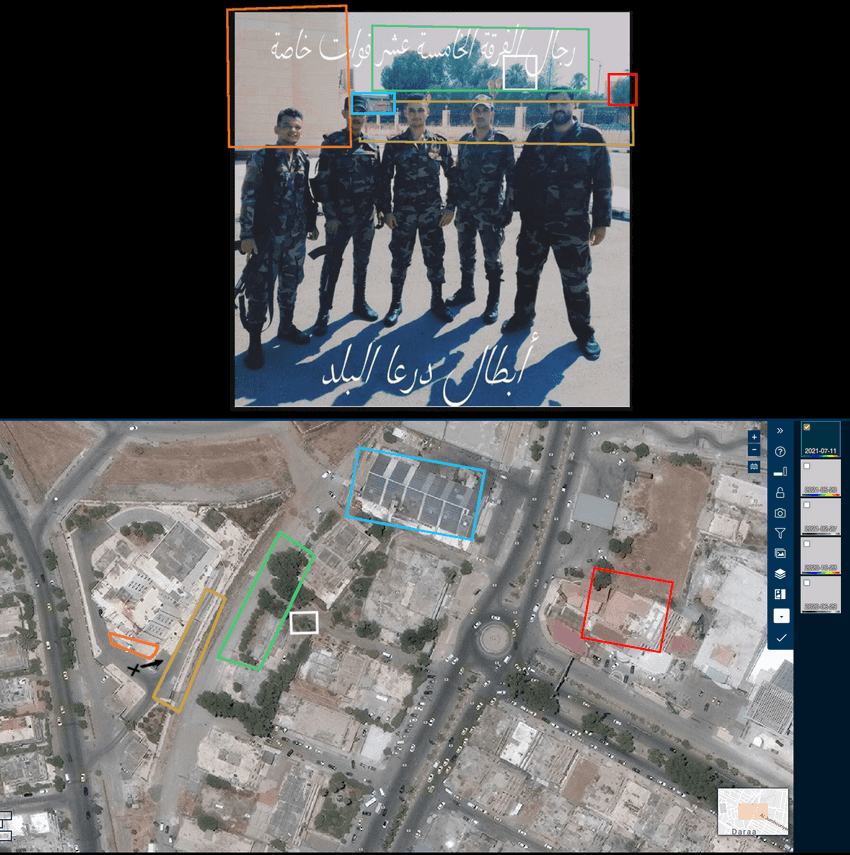 The geolocation of a picture posted by Facebook user Nazir Al Aqeel
The geolocation of a picture posted by Facebook user Nazir Al Aqeel
For the past two months, the 15th Division has maintained a presence in Daraa city as well as participated in sieges and battles in several areas of the province. Facebook pages belonging to users allied with the Syrian government documented 15th Division soldiers killed during battles in Daraa. Syrian Archive was able to confirm the posts with photos reporting the deaths of division soldiers in the Daraa governorate.
4 Armored Division
The Fourth Division is an important component of the Syrian government’s military. Founded by Rifaat Al Assad, the division holds over 15,000 soldiers and is based in the Al Muhajireen neighborhood of Damascus. One of the most heavily armed divisions of the Syrian Army, the Fourth Division is currently led by the brother of Bashar Al Assad, Maher Al Assad. The division is based in a 91 square kilometer base that includes several warehouses. The main entrance to the base is in the village of Al Hargla. Since 2011, the Fourth Division has participated in numerous battles against opposition groups in a variety of provinces. The group is accused of committing a number massacres against civilians. Most recently, videos posted online from the past two months show the presence of the Fourth Division—and its allied militias—in the Daraa governorate, participating in battles, and gathering reinforcements. A Fourth Division group often showed in Daraa is the Al Ghaith Forces.

A picture posted by the Fourth Division, Daraa Al Watan Facebook page shows Brigadier General Ghaith Dala accompanied by members of the Fourth Division in Daraa.
Al Ghaith Forces
The Al Ghaith Forces were formed by members of the Fourth Division. The group was named after its commander, Brigadier General Ghaith Dala. The forces are composed of recruited Syrians as well as other Iranian, Iraqi and Lebanese fighters. Photos and videos posted online show Ghaith Dala leading battles in Daraa—accompanied by members of several Iranian and Afghan militias.
Arab Nationalist Guard
This group is a number of militias—composed of volunteers–operating in Syria. The volunteers are from several Arab countries and support the Arab nationalist ideology. The Arab Nationalist Guard was formed at the end of 2013. The group consists of four battalions: Wadih Haddad, Haidar AL Amili, Mohammed Al Brahmi, and Joul Jamal. The group is led by Asaad Hammoud—nicknamed “Al Hajj Zulfikar”— who is located in southern Lebanon.
Syrian Archive obtained photos showing members of the Arab Nationalist Guard in the Daraa Governorate. The team verified the photos, determining the locations where the forces were stationed. In the first picture, soldiers were near a border fence. In the second picture, soldiers were near the Yarmouk suburb school outside of Daraa. Using these photos, Syrian Archive was able to confirm that soldiers belonging to the Arab Nationalist Guard were in Daraa, contrary to the claims of Arab Nationalist Guard Commander Asaad Hammoud. In an interview with Al Quds Al Arabi, Hammoud denied the presence in Daraa of any elements affiliated with the Nationalist Guards.
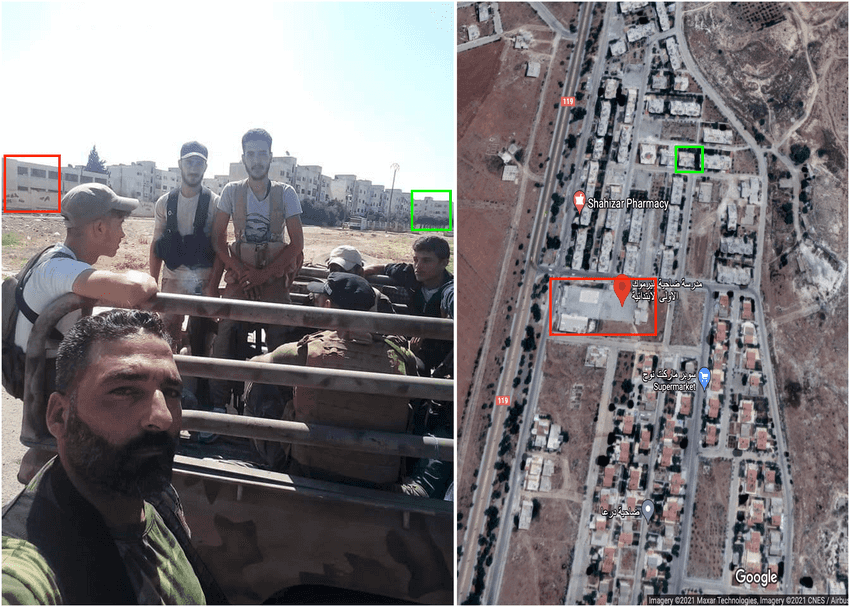 The geolocation of an image shows members of the Arab Nationalist Guard in Daraa
The geolocation of an image shows members of the Arab Nationalist Guard in Daraa
 On the right is a picture of a member of the Arab Nationalist Guard in Daraa from Nabaa News Foundation. On the left is a picture from 2018 in Yarmouk Camp, Damascus of that same member.
On the right is a picture of a member of the Arab Nationalist Guard in Daraa from Nabaa News Foundation. On the left is a picture from 2018 in Yarmouk Camp, Damascus of that same member.
Additionally, pictures obtained by Syrian Archive show Arab Nationalist Guard members in Daraa, during the 2018 battles of Yarmouk Camp in Damascus.
Fatemiyoun Brigade
The brigade was established in 2013 by Ali Tawassoli. The brigade is a prominent militia operating under the command of the Iranian forces in Syria. The majority of its fighters are from Afghanistan. The soldiers were trained by the Iranian Islamic Revolutionary Guard. Leaders of the Revolutionary Guard, including former leader Qassem Soleimani, are featured in pictures with leaders of the Fatemiyoun Brigade. The brigade has fought in battles in the Homs countryside, Daraa, Aleppo, and Hama.
 Pictures from the Nabaa News Foundation show a member of the Fatemiyoun Brigade in Daraa.
Pictures from the Nabaa News Foundation show a member of the Fatemiyoun Brigade in Daraa.
Video reports show the presence of Fatemiyoun Brigade soldiers in Daraa during recent battles. Due to the limited information available, the Syrian Archive is unable to verify the involvement of the Fatemiyoun Brigade in the recent Daraa battles.
Al Radwan Batallion
The Al Radwan Battalion was established in 2008 after the Imad Mughniyeh—also known as Hajj Radwan—was killed. The battalion is affiliated with Lebanese Hezbollah. News reports spoke of the Al Radwan Battalion’s participation in the recent battles in Daraa, mentioning specifically the arrival of the battalion with dozens of soldiers, military vehicles, and artillery. Due to the limited information available, the Syrian Archive is unable to verify the involvement of Al Radwan Batallion in the recent Daraa battles.
Abu Turab Group
Photos posted online from the Daraa province show members of the Abu Turab group in recent battles in Daraa, including Mahdi Awada, Rami Harba, and Sari Khaled Al Yassin. Al Yassin, originally from the Damascus countryside, was killed recently in Daraa.
 A picture from Nabaa News Foundation shows Mahdi Awadi in Daraa.
A picture from Nabaa News Foundation shows Mahdi Awadi in Daraa.
Photos additionally show Mahdi Awada with Ghaith Dala, commander of the Al Ghaith Forces, in the recent battles in Daraa. Photos and videos also show Mahdi Awada accompanied by the Iranian ambassador and military in Damascus as well as his participation in battles in Daraa city.
Lions of Iraq Brigade
Pictures and videos posted online show the participation of the Lions of Iraq Brigade in recent battles in Daraa. The pictures show the brigade’s commanders Fouad Al Nadawi and Abu Ali Saqr as well as the commander Sayyed Bahaa Al Hayli who was killed during the recent battles in Daraa. The brigade is under the command of the Al Ghaith Forces in Daraa.
 A picture posted by the Facebook page Horan Free Media showing Abu Ali Saqr in Daraa
A picture posted by the Facebook page Horan Free Media showing Abu Ali Saqr in Daraa
On his Facebook page, Commander Sayyed Bahaa Al Hayli posted a video on July 26 titled “We Are Coming Daraa” that shows military reinforcements in the province. Al Hayali is also shown in a video posted by his nephew on August 7. In the video, Al Hayali is accompanied by Brigadier General Ghaith Dala and other military leaders. Photos also show Al Hayli with Russian soldiers.
 *A picture posted by the Nabaa News Foundation shows Sayyid Bahaa Al Hayali in military uniform beside Russian soldiers.
*A picture posted by the Nabaa News Foundation shows Sayyid Bahaa Al Hayali in military uniform beside Russian soldiers.
According to a photo of his tombstone, Al Hayali was an Iraqi national born in 1977 in Mosul. He was buried at the Sayedat Zainab cemetery in Damascus after he was killed on August 6 in Daraa.
16th Storming Brigade
Formed by Russia in July 2020 and handed over to General Saleh Al Abdullah, the 16th Storming Brigade is stationed in three camps in the area of Tal Al Jarad near Masyaf in the western Hama countryside. The Russian military armed the regiment with armored and other military vehicles from Hmeimim base as well as artillery vehicles and Shilka anti-aircraft weapons.
Leader of the brigade, Brigadier General Saleh Al Abdullah—born in Safita, Tartus—participated in the 2011 storming of the Omari Mosque in Daraa as well as other battles in the province before he was transferred to Hama to combat protests in the city. Al Abdullah is accused of committing massacres against civilians.
 A picture from Nabaa News Foundation showing 16th Storming Brigade fighters.
A picture from Nabaa News Foundation showing 16th Storming Brigade fighters.
Photos and videos posted online show the 16th Storming Brigade in the recent battles in Daraa. A video shows the brigade on its way to Daraa with a Russian military vehicle escorting the regiment’s convoy. Receiving support from the Russian military, the brigade’s leader Al Abdullah received honors from the Russian military in February 2021. A video posted online shows the brigade’s last military operations in Daraa.
Conclusion
Through the information detailed above, Syrian Archive was able to confirm that successive multi-weapon shelling hit the town of Al Yadoudah in the Daraa governorate on July 29, 2021. The shelling hit 15 locations in the town destroying civilian homes as well as killing 5 people from two families, 4 children and a woman. Given the limitations of open source investigations, Syrian Archive is unable to definitively confirm the party responsible for the strike. However, open source information, witness testimony, and videos and images obtained by Syrian Archive point towards the Fourth Division and allied militias of the Syrian government forces as most probably responsible for this incident.
